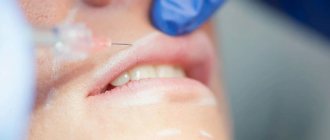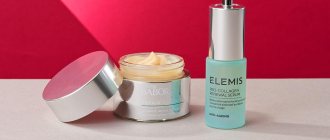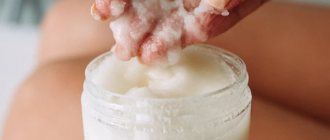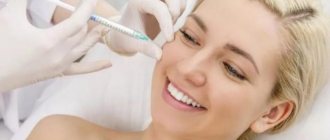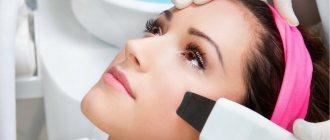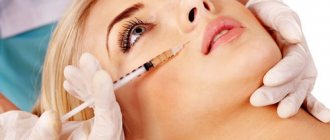When is it necessary to take care of your facial skin?
Daily skin care should be practiced throughout your life, starting at age 16.
But different facial skin care products should be used. Selection criteria are skin type and age. All cosmetics must be applied along massage lines. Violation of this rule will lead to stretching of the skin and early wrinkles.
Minimum 3 stages
There is a mandatory minimum home program, consisting of 3 stages, which should be performed daily, morning and evening.
Cleansing
- Skin cleansing. In the morning, the skin needs to be cleansed to remove traces of the night activity of skin cells, otherwise they may be absorbed back when applying the cream. Evening cleansing removes dirt and makeup. After washing, the skin should be lightly blotted with a towel; do not rub.
To avoid transepidermal loss of moisture and, as a result, dryness and tightness of the skin, you need to use “washes” that do not contain sodium sulfate.
Mechanical facial cleansing: the cost at Crystal cosmetology will be 500 rubles (makeup remover, cleaning, tonic, final cream), with a skincare procedure - 800 rubles (makeup remover, peeling, mechanical cleansing, darsonval, tonic, mask, final cream). + ultrasonic cleaning - 1000 rubles.
Toning
- Skin toning. You should wipe your face with toner after each cleansing to normalize the pH of the skin and also prepare it for the subsequent application of moisturizer. For those with all skin types (including those caring for oily skin), it is preferable to use an alcohol-free toner. For problem skin with acne, a toner with AHA acids is ideal.
Hydration
- Skin moisturizing. A must-have step even when caring for oily skin! Lack of moisture in the epidermis is the path to early skin aging.
It is recommended to apply day cream at least 30 minutes before going outside. The optimal time to apply night cream is 1-2 hours before going to bed: the facial care product is effective only when the muscles are mobile. Girls under 25 years old do not need to use night cream, as young skin repairs itself. Evening care can be reduced to cleansing and toning. In addition, in order for the skin to remain smooth and fresh, it is necessary to periodically free it from dead cells. To do this, you can scrub your face 2 times a week. Owners of problem skin with acne should not perform deep cleansing, and if the skin is overly dry, sensitive, you can use the scrub less often - a couple of times a month.
What happens to your skin after peeling?
If you are interested in the question of whether it is possible to visit a bathhouse after facial peeling, then think about how this will affect injured skin? What effect will elevated temperature and profuse sweating have on her?
If you evaluate the condition of a woman’s skin after exfoliation, then an analogy with a burn is appropriate. Moreover, the stronger the concentration and depth of penetration of the exfoliant, the greater the trauma to the skin. Peeling is a serious stress for the body, requiring a period of rehabilitation to restore the integrity of the damaged skin.
Interesting: the first peel using salicylic acid and resorcinol was done in Germany at the end of the 19th century.
During the exfoliation process, the active components destroy the fibers of the epidermis, which die and flake off from the surface of the epidermis. In their place, a layer of new cells is formed, characterized by firmness and elasticity. Through a woman's eyes it looks very unpleasant. Redness, inflammation and swelling are replaced by profuse peeling of the skin.
The main thing at this difficult moment is to allow the body to restore the damaged area without interfering with the natural process. Follow the recommendations of cosmetologists, use only approved products. If you do not follow the advice, you take upon yourself all the side effects and complications of the post-peeling condition.
What types of skin care treatments are there?
“How to properly care for your facial skin,” millions of women are interested in. We answer: it is ideal when competent home skin care is combined with regular visits to a cosmetologist. During skincare procedures, the doctor, depending on the age and skin type of the client, selects a program that allows solving a specific problem. Most skin care procedures include: cleansing the skin, light peeling, toning, facial massage (classical, plastic, Jacquet or lymphatic drainage), application of an active concentrate, then a mask. Also, skincare procedures are often performed according to a more accelerated program: peeling, facial massage and, of course, applying a mask - cream, alginate, collagen or Matrigel.
In addition, the price list of many salons separately includes facial massage, which is recommended to be carried out in a course of 10-15 sessions. This massage improves blood microcirculation, strengthens the muscular frame of the face, providing a lifting effect. To enhance the result, concentrates are usually applied under the massage cream. When caring for the face after 40 to reduce wrinkles, a more noticeable effect, of course, will be from hardware or injection methods.
After skincare procedures, a cosmetologist, having diagnosed the skin, can select facial skin care products at home. The effect of properly selected professional cosmetics for facial skin care will be many times higher than from using self-selected mass market products.
In addition to various facial procedures, the price list of salons also usually includes care programs for the skin of the eyelids, neck and décolleté.
Laser: getting rid of serious skin imperfections
How will it help? Will remove manifestations of rosacea, age spots, deep wrinkles.
When to do it? To fully enjoy the results, it is advisable to go for the procedure at least three weeks before important events.
What to choose? Lasers are available in non-ablative and ablative types.
- Non-ablative lasers (neodymium laser, phototherapy) do not damage the skin and have a gentle effect on it. Since they act in the deeper layers of the epidermis, they cope perfectly with pronounced wrinkles.
- Ablative lasers (erbium, CO2 laser) damage the skin to stimulate collagen synthesis. The method is effective for correcting fine wrinkles, hyperpigmentation and treating post-acne, as well as rejuvenating the eye and lip area.
Indications for care procedures
Since skincare procedures are individually selected, they can solve almost all skin problems, including facial care after 40 years. Main indications:
- problematic skin with rashes, enlarged pores, increased oiliness
- rosacea
- dry, dehydrated skin
- presence of age-related changes (fuzzy oval face, loss of skin elasticity)
- swelling of the face and eyelids
- the need to restore skin after surgical interventions
- prevention of aging
- hyperpigmentation.
upcoming special event (most salons offer express programs for radiant, fresh skin)
Contraindications for facial skin care
Since care programs are usually selected individually (after consultation), it is difficult to identify common contraindications. Most manufacturers offer “designer” facial skin care products that can be combined with each other to create a program that is suitable specifically for this client.
Alginate masks, the most popular salon procedure, have virtually no contraindications (only individual intolerance to the components). There are more restrictions when doing facial massage:
- violation of the integrity of the skin, its inflammation, including acute dermatoses
- active stage of herpes
- infectious diseases
- bleeding
- diseases of the trigeminal nerve, circulatory system
malignant neoplasms.
When doing facial massage according to Jacquet (it is often used for problem skin with acne), pronounced rosacea is added to this list.
Effectiveness of facial skin care
Many clients believe that home care using professional cosmetics can replace care treatments in the salon. It is a mistake to think so. Each manufacturer's assortment includes facial care products intended for salon and home use. Professional preparations have a higher concentration of active substances, but using them without special training is difficult and sometimes dangerous. In addition, since care programs are developed individually, using facial skin care cosmetics that complement each other, the effect cannot be compared with the consequences of self-medication!
Another common misconception: skincare procedures are less effective than hardware and injection techniques. Since the mechanisms of action are different, there is no point in comparing these techniques. The result depends on the desired effect. For example, to improve the condition of the upper layers of the skin, treatments using high-quality facial care products can provide better results than other techniques. Often, to achieve the best effect, a cosmetologist combines hardware, skincare and injection techniques.
Therefore, to the question “How to care for your facial skin?” the answer is always different. The transformation program is individual for each patient. Some girls are better suited for skin care treatments using high-quality facial skin care products, while others prefer a combination of several techniques. The main thing is to quickly achieve your goal, namely, a professional with a medical education will recommend optimal care for oily skin, facial care after 40, etc.
What is considered normal after peeling?
- Pimples after peeling are not uncommon and are no exception, especially if exfoliation was carried out just to get rid of them. The first way to eliminate it is acne. What to do - consult a cosmetologist - if the rash is severe, antibiotics and vitamins may be prescribed;
- Peeling after peeling is more than normal - it is with peeling skin that tissue renewal occurs. Peeling should never be peeled off or even gently removed, this can lead to complications. All crusts will fall off on their own. By the way, if your face does not peel, there is nothing wrong with that either: firstly, after some peelings there is no peeling, and secondly, the characteristics of the skin could influence it.
- Redness as a consequence of the burn gradually disappears during the healing process.
- Swelling of the face - especially after a medium peel lasting up to 3-5 days, in the case of a deep peel a little longer.
What is not considered the norm and requires consultation with a cosmetologist:
- inflammatory processes;
- cracks in the skin (as a result of poor hydration);
- pigmentation (may appear if there was no sun protection or the patient has a high predisposition);
- erythema;
- allergy;
- exacerbation of herpes;
- hypertrophic and keloid type scars.
Answers to important questions
The care and consequences are more or less clear, but here’s how things are going with the return to normal life.
- Is it possible to go to the bathhouse or sauna , to the pool and take a bath after peeling?
No. Water procedures in the pool are fraught with infection, and chlorinated water is dangerous due to irritation, the possibility of getting burned and drying out the skin.
Taking a bath, sauna and bath procedures are dangerous due to high temperatures, and this in turn causes sweating - that is, skin irritation, plus in a warm environment, bacteria actively multiply. You can return to your favorite water treatments after the skin has completely healed.
- Can I exercise after peeling?
Any workout leads to sweating, which, as in the case of bath procedures, leads to burning and irritation of the skin.
- When can you sunbathe/go to a solarium?
Sunbathing, both natural and artificial, is highly likely to cause hyperpigmentation, so you should abstain from tanning during the peeling course and for a month.
It is this factor that makes it preferable to carry out peelings during periods with minimal solar activity.
- Can I drink alcohol after peeling ?
Definitely no - at least a week or two, if peelings are carried out in a course - abstain for the entire period!
Why and what is fraught with:
- increased burns when interacting with chemical residues in the skin;
- intense erythema;
- increased swelling of the face and eyes;
- ineffectiveness of some types of peelings, the appearance of unwanted reactions of the body.
- Is it possible to make face masks?
Natural masks are completely prohibited, as they can cause inflammation on burned skin, injure particles and cause allergic reactions.
It is better to pay attention to professional masks designed for post-peeling care - mainly aimed at deep moisturizing, soothing and restoring the skin.
- When can you put on makeup or use foundation after a peeling procedure?
After superficial peeling, as a rule, it is allowed to apply cosmetics (tone, highlighter, powder, etc.) every other day. After medium and deep peeling, you should abstain for 7-14 days. It is worth noting that mascara and lipstick are not included in the prohibited list.
- Is it possible to cleanse your face after peeling?
In some cases, this is possible; after some light types of exfoliation, it is also possible to combine procedures. Only a cosmetologist can answer with accuracy.
- Is it possible to do peeling after biorevitalization and mesotherapy?
As a rule, there is no prohibition on carrying out; procedures often take place in parallel or at intervals. Only a cosmetologist can give an exact answer in accordance with the desired result and skin condition.
- Is it possible to peel after Botox/Dysport and filler?
Only a cosmetologist can give an answer, taking into account the time elapsed after the procedure and what type of peeling should be carried out. The fact is that after Botox or filler injection, the blood vessels in the treated area are compressed, this condition slows down the process of skin regeneration.
